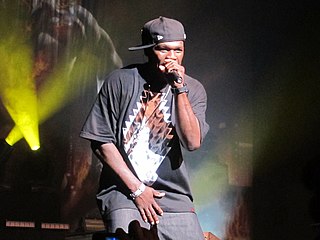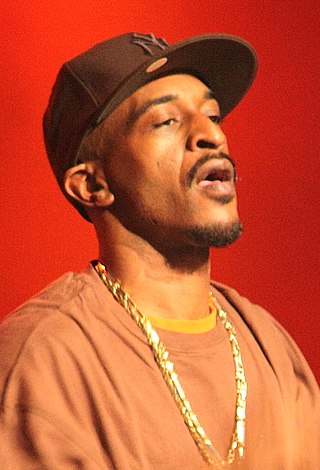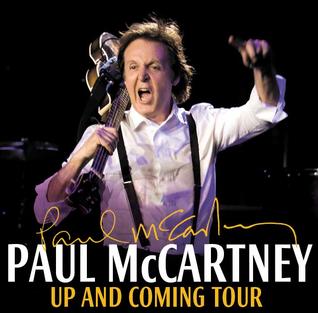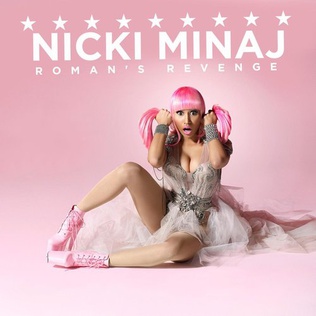In poetry, internal rhyme, or middle rhyme, is rhyme that occurs within a single line of verse, or between internal phrases across multiple lines. [1] [2] By contrast, rhyme between line endings is known as end rhyme.
Internal rhyme schemes can be denoted with spaces or commas between lines. For example, "AB,AB,AB" denotes a three-line poem with the same internal rhyme on each line, and the same end rhyme on each line (which does not rhyme with the internal rhyme).
The following example is in limerick form. Each stressed syllable rhymes with another stressed syllable using one of three rhyme sets. Each rhyme set is indicated by a different highlight color. Note that the yellow rhyme set provides internal rhyme in lines 1, 2, and 5, and end rhymes in lines 3 and 4, whereas the blue set is entirely internal, and the pink is exclusively end rhymes.
Each time Rosalie goes for a walk
She well knows that her clothes are the talk
Of the town, and it shows,
But this gown will expose
More than toes, so some shmoes gape and gawk.
Percy Dearmer (1867–1936) revised John Bunyan's (1628–1688) poem "To Be a Pilgrim" in 1906. It became a popular hymn when Charles Winfred Douglas (1867–1944) set it to music in 1917. Here are Dearmer's lyrics, with the internal rhymes in bold. Notice that in these three quatrains the internal rhymes are also echoed in the line rhymes (also in bold). [3]
He who would valiant be ’gainst all disaster,
Let him in constancy follow the Master.
There’s no discouragement shall make him once relent
His first avowed intent to be a pilgrim.
Who so beset him round with dismal stories
Do but themselves confound—his strength the more is.
No foes shall stay his might; though he with giants fight,
He will make good his right to be a pilgrim.
Since, Lord, Thou dost defend us with Thy Spirit,
We know we at the end, shall life inherit.
Then fancies flee away! I’ll fear not what men say,
I’ll labor night and day to be a pilgrim.
W. S. Gilbert (1836–1911) used internal rhyme in some of the songs of his operas. One notable example is that of Bunthorne's solo aria from the opera Patience , which begins:
If you're anxious for to shine in the high aesthetic line
As a man of culture rare,
You must get up all the germs of the transcendental terms,
And plant them everywhere.
You must lie upon the daisies and discourse in novel phrases
Of your complicated state of mind,
The meaning doesn't matter if it's only idle chatter
Of a transcendental kind.
Internal rhyme schemes were extremely common in a popular song of the Swing Era. One familiar example is the bridge from "Don't Fence Me In", written by Cole Porter for the film Hollywood Canteen in 1944:
Just turn me loose let me straddle my old saddle,
Underneath the western skies,
On my cayuse let me wander over yonder,
'Til I see the mountains rise.
Internal rhyme is used extensively in rap and hip-hop music, where it sometimes overlaps with assonance. The usage of internal rhyme in rap has increased over time, but can be found even in the earliest rap songs, such as the Sugarhill Gang's 1979 single, "Rapper's Delight": [4]
I'm six-foot-one and I'm tons of fun and I dress to a T
You see, I got more clothes than Muhammad Ali and I dress so viciously
I got body guards, I got two big cars, I definitely ain't the whack
I got a Lincoln Continental and a sun-roofed Cadillac
So after school, I take a dip in the pool, which is really on the wall
I got a color TV, so I can see the Knicks play basketball
Internal rhyme is used frequently by many different hip-hop artists, including Kool Moe Dee, Big Daddy Kane, Nas, and Rakim, as demonstrated in Eric B. and Rakim's 1987 piece, "My Melody" from their debut album Paid In Full :
My unusual style will confuse you a while
If I were water, I'd flow in the Nile
So many rhymes you won't have time to go for yours
Just because of applause I have to pause
Right after tonight is when I prepare
To catch another sucker-duck MC out there
My strategyhas to betragedy,catastrophe
And after this you'll call me your majesty... [5] [6]
Another prominent hip-hop artist who uses complex internal rhymes is AZ, as shown in "The Format":
Young and gifted, my tongue's prolific
In the beach bungalow is how I brung in Christmas
To the streets I'mma flow from the hungriest districts
Swiss kicks crisp when I come to them picnics
Play slow, paper chase stack and lay low
Range rove tinted all black the same old
Psychic mind, righteous rhymes that turned a new leaf from a life of crime
No concerns with new beef, who's as nice as I'm
It's confirmed, from few feet I'm still a sniper blind
Built my fame, spilt my pain
Politicking daily, still trying to milk the game
It's obvious that I'm real, rap skills remain
I took some change and I'm still the same
Black Thought, rapper from The Roots, uses internal rhymes in the song "Respond/React".
The attractiveassassin, blastin the devil trespassin
Master gettin cashin an orderly fashion
Message to the fake n**** flashin
Slow up Ahk, before you get dropped and closed like a caption
Fractional kids don't know the time for action
Styles got the rhythm that of an Anglo-Saxon
Round of applause, an avalanche of clappin
{*BLOW*} that's what happen, now what's your reaction
We heavyweight traction, pro-pornographin
Specialize in science and math and, original black man
Bustin thoughts that pierce your mental
The fierce rippin your sacksand
Vocal toe to toe impeccable splittin your backson
Simple as addition and subtraction
BlackThought, the infiniterelaxedone
Shorties say they love it with a passion
Bring the international charm, see a squad I harass
The Beatles use internal rhyme in their song "Hey Jude".
Hey Jude, don't make it bad
Take a sad song and make it better
Remember to let her into your heart
Then you can start to make it better
Hey Jude, don't be afraid
You were made to go out and get her
The minute you let her under your skin
Then you begin to make it better
MF Doom uses almost every word as internal rhyme in this verse in his song, "Figaro". (Rhymes highlighted)
It's too hot to handle , you got blue sandals
Who shot you ? Ooh got you new spots to vandal ?
Do not stand still , both show skills
Close but no krills , toast for po' nils , post no bills
Coast to coast Joe Shmoe's flows ill , go chill
Not supposed to overdose, No-Doz pills
Off pride tykes talk wide through scar meat
Off sides like how Worf rides with Star fleet
Kool Keith heavily utilises internal rhyme in his song "3000" to effectively throw off the listener.
As studies have shown; participator acts walk up, clog up
And mess up water down the sound that comes from the ghetto
In the middle the core you tour, exploreexperience
What is real you feel, changing ways
Commercial rap's in the grave, stuff on disc that's very wack
That you saved, you think it's good won't go platinum
Or even turn wood, sell the cassette
Your homey's tape deckgets wet
You my pet, my poodle chicken noodle's on the rise
Open your eyes and see mylife
Rap moves on to the year three thousand!

Rapping is a musical form of vocal delivery that incorporates "rhyme, rhythmic speech, and street vernacular". It is performed, usually over a backing beat or musical accompaniment. The components of rap include "content", "flow", and "delivery". Rap differs from spoken-word poetry in that it is usually performed off-time to musical accompaniment. Rap is a primary ingredient of hip hop music commonly associated with that genre.

Eric B. & Rakim are an American hip hop duo formed on Long Island, New York, in 1986, composed of DJ Eric B. and MC Rakim. AllMusic wrote that "during rap's so-called golden age in the late '80s, Eric B. & Rakim were almost universally recognized as the premier DJ/MC team in all of hip-hop." Tom Terrell of NPR called them "the most influential DJ/MC combo in contemporary pop music period." The editors of About.com ranked them as No. 5 on their list of the 10 Greatest Hip-Hop Duos of All-Time, and Rolling Stone ranked them No. 5 on its list of the 20 Greatest Duos of All Time.

Life After Death is the second and final studio album by American rapper The Notorious B.I.G., released on March 25, 1997, on Bad Boy Records and Arista Records. A double album, it was released sixteen days after his murder. It features collaborations with guest artists such as 112, Jay-Z, Lil' Kim, Mase, Bone Thugs-n-Harmony, Too $hort, Angela Winbush, D.M.C. of Run-D.M.C., R. Kelly, The Lox, and Puff Daddy. Life After Death exhibits The Notorious B.I.G. further delving into the mafioso rap subgenre. The album is a sequel to his first album, Ready to Die, and picks up where the last song, "Suicidal Thoughts", ends.

William Michael Griffin Jr., better known by his stage name Rakim, is an American rapper and record producer. One half of golden age hip hop duo Eric B. & Rakim, he is widely regarded as one of the most influential and skilled rappers of all time.

Paid in Full is the debut studio album by American hip hop duo Eric B. & Rakim, released on July 7, 1987, by Island-subsidiary label 4th & B'way Records. The duo recorded the album at hip hop producer Marley Marl's home studio and Power Play Studios in New York City, following Rakim's response to Eric B.'s search for a rapper to complement his disc jockey work in 1985. The album peaked at number fifty-eight on the Billboard 200 chart, number eight on the R&B/Hip-Hop Albums chart, and produced five singles: "Eric B. Is President", "I Ain't No Joke", "I Know You Got Soul", "Move the Crowd", and "Paid in Full".

The Hip Hop Honors is an annual event that airs on VH1. The television special honors old school and golden age hip hop rappers and contributors for their long-term influence and importance in the history of hip hop culture. It features live performances by most of the honorees along with new artists who have been influenced by them in tribute. The show is taped at the Hammerstein Ballroom in Manhattan, New York City.
The Treacherous Three was a pioneering American hip hop group that was formed in 1978 and consisted of DJ Easy Lee, Kool Moe Dee, L.A. Sunshine, Special K and Spoonie Gee, with occasional contributions from DJ Dano B, DJ Reggie Reg and DJ Crazy Eddie. They first appeared on record in 1980 on the B-side of Spoonie Gee's single, "Love Rap".

Illmatic is the debut studio album by American rapper Nas. It was released on April 19, 1994, by Columbia Records. After signing with the label with the help of MC Serch, Nas recorded the album in 1992 and 1993 at Chung King Studios, D&D Recording, Battery Studios, and Unique Recording Studios in New York City. The album's production was handled by DJ Premier, Large Professor, Pete Rock, Q-Tip, L.E.S., and Nas himself. Styled as a hardcore hip hop album, Illmatic features multi-syllabic internal rhymes and inner-city narratives based on Nas' experiences growing up in the Queensbridge Houses in Queens, New York City.
"War with God" is a song on the album Release Therapy by rapper Ludacris. Released in July 2006, the song saw Ludacris return to music after some time off to concentrate on his acting career.
A chronological listing of songs produced by will.i.am.
"Know the Ledge" – originally on the soundtrack of the film Juice as "Juice (Know the Ledge)" – is a 1992 single by hip-hop duo Eric B. & Rakim. The film's theme song, also released on the duo's 1992 album Don't Sweat the Technique, it features a distinctive sample from Nat Adderley's 1968 hit "Rise, Sally, Rise".

The Beatles Box is an eight-record box set of Beatles recordings, initially released on 3 November 1980 by World Records, a mail-order subsidiary of EMI. It was also issued in two formats by Reader's Digest in New Zealand, Australia and Mexico.

When rapping, MCs use braggadocio to boast—to speak about themselves with great pride. Braggadocio may include subjects such as physicality, fighting ability, financial riches, sexual prowess, or "coolness". Often heavily used in battle rap, braggadocio lyrics can range from just saying, "I'm the best MC ever," to using elaborate phraseology and wit.

The Up and Coming Tour was a concert tour by Paul McCartney. The tour began on 28 March 2010, at the Jobing.com Arena in Glendale, Arizona, northwest of Downtown Phoenix. As with McCartney's other concert tours as a solo artist, the setlist for the Up and Coming Tour was composed of songs by his former bands the Beatles and Wings, as well as songs from his solo career. The tour included two concerts at the Hollywood Bowl in Los Angeles, followed by concerts in Miami and San Juan, the latter marking both McCartney's first concert in Puerto Rico and the first visit by a member of the Beatles. The tour ended on 10 June 2011 with a show in Las Vegas, Nevada.

"Roman's Revenge" is a song by Trinidadian-born rapper Nicki Minaj featuring American rapper Eminem, performing as their respective alter egos Roman Zolanski and Slim Shady. Taken from her debut studio album Pink Friday (2010), written alongside producer Swizz Beatz. It was released exclusively on October 30, 2010 through the United States iTunes Store, as a promotional release preceding the album's release.

On the Run was a concert tour by English singer-songwriter Paul McCartney. The tour began on 15 July 2011, with McCartney's first two concerts at Yankee Stadium in New York City. McCartney's appearances at Yankee Stadium occurred nearly two years to the day after his 17, 18, and 21 July 2009 concerts at Citi Field, documented on the Good Evening New York City CD/DVD.

One on One was a concert tour by English musician Paul McCartney that began on 13 April 2016 and traveled through the United States, Canada, Argentina, Germany, France, Spain, the Netherlands, the Czech Republic, Norway, Denmark, Belgium, Japan, Brazil, Mexico, Australia and New Zealand, ending on 16 December 2017. The tour marked McCartney's first-ever performances in Fresno, South Dakota, and Arkansas. Prior to the announcement of the tour, McCartney revealed two European festival dates for June 2016 at the Pinkpop Festival and Rock Werchter respectively.
"Talk to Me" is a song by American rapper Drakeo the Ruler featuring Canadian rapper Drake. It was released on February 23, 2021, as the lead single from the former's ninth mixtape The Truth Hurts (2021). The song was produced by EY and Elias Knight.